Hi Everyone,
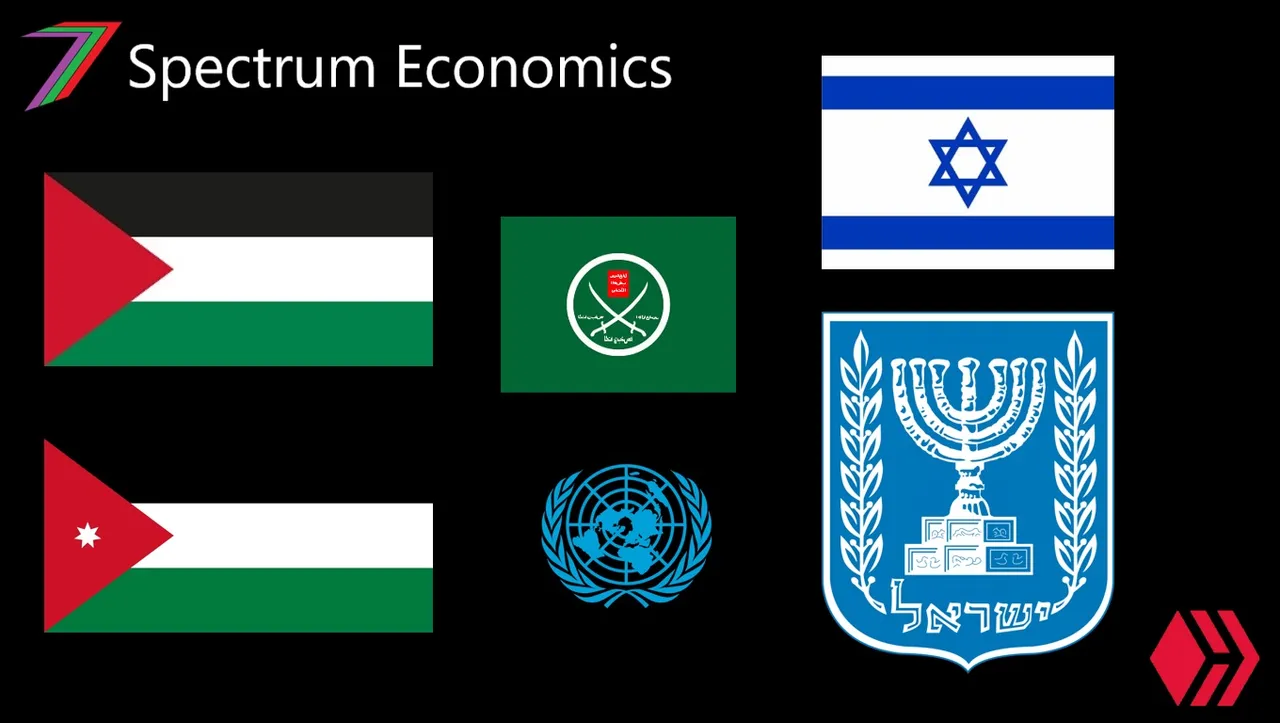
Welcome to Part 4 of my five part series discussing the possible collapse of western civilisation, as we know it today. Part 4 is a continuation of Part 3. In Part 3, I discussed how the war between Israel and Hamas has been a trigger for tensions around the world. In Part 4, I discuss some of the history and problems between Palestine and Israel. This part serves to add context to the other parts in this series.
Disclaimer: The issues between Israel and Palestine are complicated. I have read many different accounts of the problems between the two sides. Facts presented are tainted by opinions. There are various interpretations of events and the motivations. In this post, I attempt to understand the evidence as best I can. I will never be as well informed as those who are closer to events but I am also less likely to have a strong bias. In terms of my own bias. I have long sympathised with the Palestinian’s circumstances. However, as I dig deeper into the problems and the lesser publicised facts, I find myself more sympathetic towards Israel’s position, which is less apparent to outsiders. It is important to have flexible opinions that can change when presented with different evidence.
Modern Day Palestine
In 1988, through the Palestinian Declaration of Independence, the State of Palestine was formally established. However, the Palestinian Government had no control or authority over any territory. It was not until 1994, through the Gaza-Jericho Agreement, that Palestine could self-govern (Wikipedia). The West Bank Palestinian territory is partially ruled by the Palestinian Authority. The West Bank is fragmented into 165 Palestinian enclaves. The rest of the West Bank is under full Israeli control. After Israel’s withdrawal from Gaza in 2005 (Wikipedia), Gazans were given the opportunity to self-govern. They elected Hamas. This triggered several years of fighting. Since 2007, Hamas have had full control of Gaza. In 2012, Palestine was upgraded to the status of non-member observer state in the United Nations. Currently, Palestine is widely but not universally recognised as a state.
West Bank Problems
The disconnectivity between the Palestinian settlements on the West Bank is a huge problem. This disconnectivity has been estimated to vastly reduce economic growth and significantly raise the level of unemployment of Palestinians (World Bank). Hence, West Bank Palestinian standards of living are considerably lower than they could be if the settlements were located in one continuous block. However, this assessment is based on the assumption that the West Bank would be well governed and organised. There is the possibility that the West Bank could become like Gaza; discussed later in this post. The problems of fragmentation has its roots in the methodology applied to early partition plans; also discussed later in this post.
Israeli authorities have aggravated the situation by enabling the increase in the number of Israeli settlements on the West Bank. This has been accompanied by more policing and greater requirements for security (Britannica). West Bank Palestinians have legitimate reasons for grievance regarding the actions of the Israeli authorities. However, if the threat of violence were not as high, there would be less reason for the security measures that have been put in place. West Bank Palestinian support for Hamas is a strong indication of the security risk that they pose; discussed later in this post. Palestinians should also blame their own Government for their lack of cooperation in regards to improving their circumstances. Many deals have been brokered that could have greatly improved the West Bank’s circumstances (BESA).
Gaza and Hamas
Palestinians in the Gaza Strip face a different problem. Their biggest problem is from within. Hamas has full control over the Gaza Strip. They do not act in the best interests of the Palestinian people. For example, in the 2012, Hamas killed 160 Palestinian children during the construction of their terror tunnels (Tablet).
Hamas are focused on the destruction of Israel. Sadly, despite their heinous ambitions, it appears they have significant support from both Gazan and West Bank Palestinians. See Figure 1 below.
Figure 1: Palestinian Support for 7th October and various organisations.

Sources: Arab World for Research and Development and Dr. Eli David
This is not just apparent from polls but also through actions. For example, Gilad Erdan (Israel Ambassador to the United Nations) posted a short clip of Gazan Palestinians watching an outdoor public screening of the atrocities committed by Hamas on 7th October. Another, more frequently shared example are the scenes of the body of the girl, Shani Louk, taken from the Supernova Music Festival being paraded in the streets of Gaza (Dion). Yet another example is the Hamas terrorist who called his family to celebrate killing Jews. He bragged about how many he had killed and his parents were celebrating with him (New York Post).
Hamas have done a very good job of brainwashing the Gazan Palestinians. They begin this brainwashing through their education. Palestinian children are taught from a very young age to hate Jews. They are even taught that it is acceptable to sacrifice their own lives to kill Jews. This would make them martyrs (Why Evolution is True).
Some of these children grow up to become fighters/terrorists for Hamas and many of them pass their hatred onto their children. Ultimately, hatred on one side will translate into hatred on the other side. For example, since 7th October, there has been an in increase in violence from Israeli settlers towards Palestinians on the West Bank (The Intercept). This leads to a cycle of never ending hatred and violence.
Children in western countries are also being brainwashed through their education systems but in a different way; briefly discussed in Part 3 and to be revisited in Part 5.
Mosab Hassan Yousef is the son of Sheikh Hassan Yousef, a co-founder of Hamas. Mosab Hassan Yousef has spoken out strongly against Hamas and their methods of indoctrination. He has appeared on various media, He even spoke at the United Nations regarding the actions of Hamas and their intentions. In 2010, he authored the book Son of Hamas in which he describes his experience of the inner workings of Hamas.
How Bad is Gaza?
In western media, the Gaza Strip has been repeatedly referred to as an open-air prison. Borders exist between Gaza and Israel as well as Egypt. These borders serve the purpose of security. They are justified to mitigate the potential threat of Hamas to Israel and possibly Egypt. The borders do not prevent all Gazans from leaving. Israel issues work permits to Gazans; 15,500 work permits were issued in 2022 (AP News). I could not find any data on the number of work permits Egypt has offered Gazans.
Gazans can also migrate to other countries if they meet their visa requirements. Net migration from Gaza is -3.8 migrants/1,000 population (CIA World Fact Book). Gazan mobility is likely to limited by economic factors. This is the same for all countries. Hamas may also play a role in limiting residents’ mobility. Calling Gaza an open-air prison seems like an exaggeration.
The Mail Online published an article revealing Gaza to be a far pleasanter place than typically portrayed by most media. They had markets, picturesque beaches and parks, modern shopping centres, hotels and restaurants. This war has put all of this at risk. See pictures below.
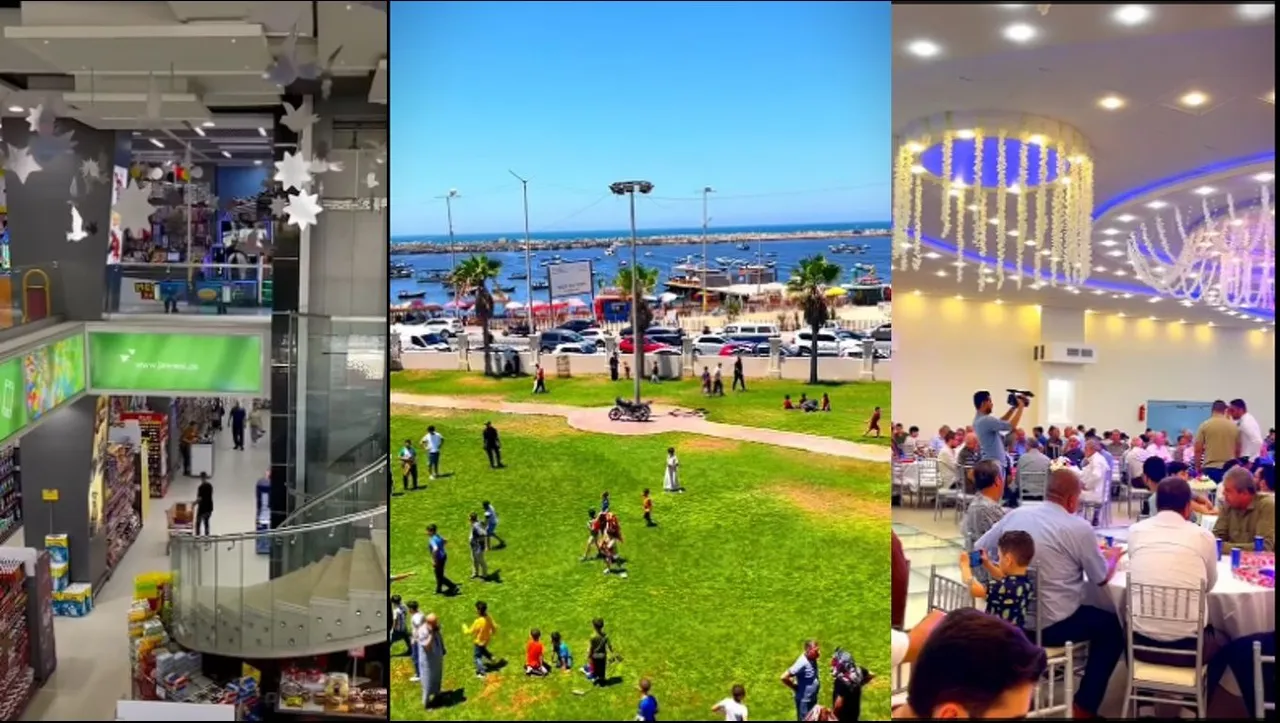
Source: Mail Online
To add a little more perspective, we could also compare the quality of life of Gazans with those of Indigenous Australians living in the Northern Territories. The environment is completely different but I use this comparison because Australia is a developed western country with communities of indigenous people.
Table 1: Comparison between Gazans and Indigenous Australians Indicators of Standard of Living
| Statistics | Gazans | Indigenous Australians (NT) |
|---|---|---|
| Male Life Expectancy (yrs) | 73 | 65.6 |
| Female Life Expectancy (yrs) | 76.8 | 69.4 |
| Monthly Income (Median) USD | 1510 | 1228 |
| Unemployment Rate | 24% | 27% |
| Illiteracy | 3% | 46% |
| Cancer rate per 100,000 | 32.7 | 500 |
| Long-Term Illness | No Data | 32% |
| Suicide (% All Deaths) | No Data | 6% |
| Suicides per 100,000 population | No Data | 29.9 |
| Mental Health Problems | 40% | 24% |
| Food Security | 64% | 43% |
Sources for Gaza:
Aljazeera
Borgen Project
National library of Medicine
Salary Explorer
Trading Economics
Wikipedia
Sources for Indigenous Australians Northern Territory:
ABS
ABS, Census
Australian Institute of Health and Welfare
Australian Institute of Health and Welfare
Australian Institute of Health and Welfare Reports
Australian Institute of Health and Welfare Reports
Borgen Project
Note: Plenty of articles point out the high suicide rate in Gaza but none includes data that can be used for comparison. Northern Territory Indigenous Australians would have the fifth highest suicide rate in the world if compared with other countries.
The above statistics indicate that an average Gazan’s quality of life is likely to be better than that of an average Indigenous Australian living in the Northern Territory. This does not indicate Gazans have a high standard of living but the outrage over it is disproportionate compared to another group of people living in a developed western country, who we would expect to have a higher standard of living.
More than just Hamas
The Israeli Government have pledged to destroy Hamas. This might be an impossible feat. Hamas ideology is embedded in many Gazan Palestinians. Even if all current Hamas fighters are killed, new ones will join. They come from today’s brainwashed children or from groups infiltrating Gaza. Many of the Hamas’ highest ranking leaders are not located in Gaza. Many are located in Qatar and others are living in other parts of the world. If Hamas are to be completed defeated, they need to be defeated from within. Gazan Palestinians need to be willing and able to dispose of them. At this point, it appears unlikely to happen.
Middle Eastern countries hatred is not purely reserved for Jews. Many of them also hate Christians and western society.
Figure 2: Opinions of Religions in a sample of Predominantly Muslim Countries
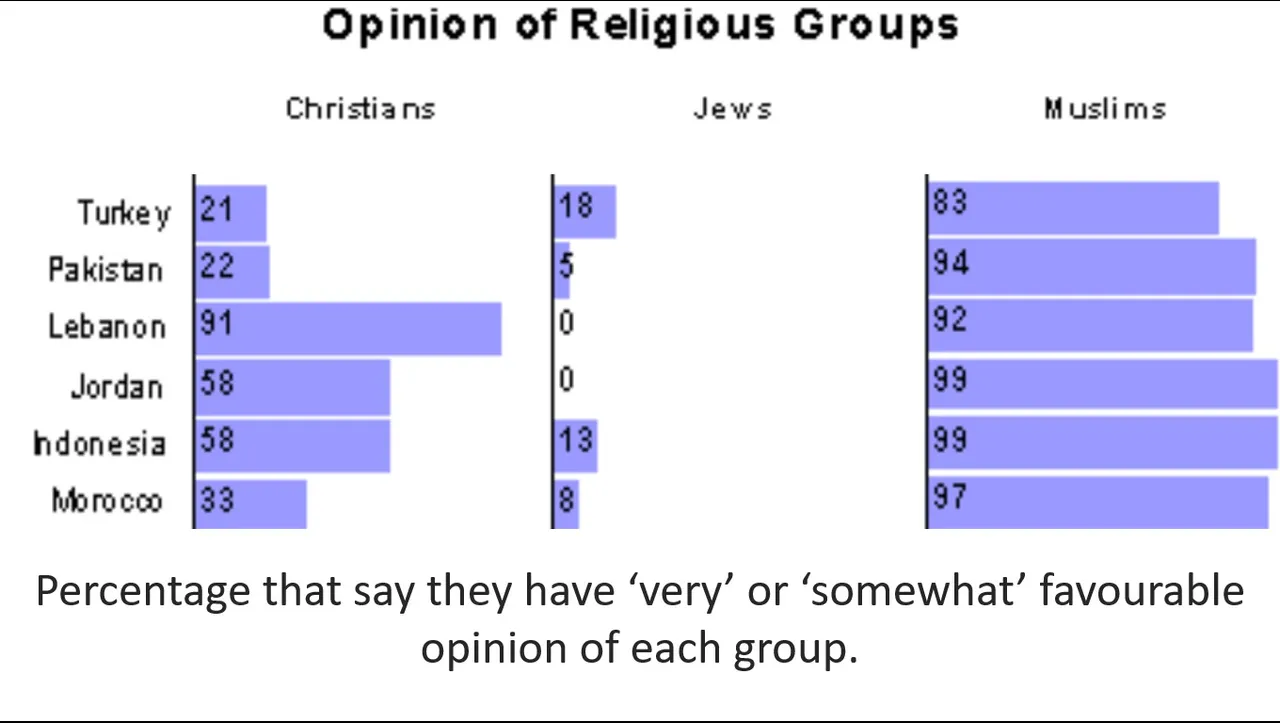
Source: Pew Research Center
A century ago, in the Middle East and North Africa, the population of Christians used to be about 20%. It is now less than 4%. They have experienced extreme persecution and even genocide (The Guardian).
Hamas are not an isolated terrorist group. They were created by the Muslim Brotherhood (The Avalon Project). The Muslim Brotherhood support radical Islamic-based ideology. They have a presence across the Middle East, North Africa, and even Europe. Leaders from Qatar, Turkey and sometimes Iran as well as non-state organisations such as the Syrian Opposition and the Al-Nusra Front support and ally with the Muslim Brotherhood (Wikipedia).
Arguably, until their relationship soared over recent decades, the biggest sponsor of the Muslim Brotherhood was the Saudi Royal Family (Fikra Forum). The Muslim Brotherhood have been involved in attempts to bring down Governments in countries such as Syria and Egypt. They are anti-communism and claim to be anti-imperialism (Eric Draitser). The Muslim Brotherhood even had a working relationship with UK and US Government agencies, which may continue to this day (Mother Jones). We could argue that they are a tool for the establishment.
Right to the Land
For many, the essence of the conflict between Israel and Palestine is land. Who should control what land and how much land should either side control. Despite the long history the Jews have to the Levant Region, Israeli Jews are considered the outsiders trying to take away land from the indigenous Levantines.
Over the thousands of years, people from this region have been conquered, killed, converted to other religions, taken away as slaves, forcibly displaced, etc... The ancestors of the people who inhabited the ancient Kingdom of Israel (Modern day Israel, Jordan, and part of Lebanon) are spread out around the world. Very few, if any, people have 100% Levantine lineage. Palestinians have some Levant ancestry but they also have ancestry linking them to Arab tribes from the Arab Peninsula (Jerusalem Center for Public Affairs). In the 20th century, people of Jewish faith migrated to Israel from a wide variety of places. See Figure 3 below.
Figure 3: Migration of Jews to Israel
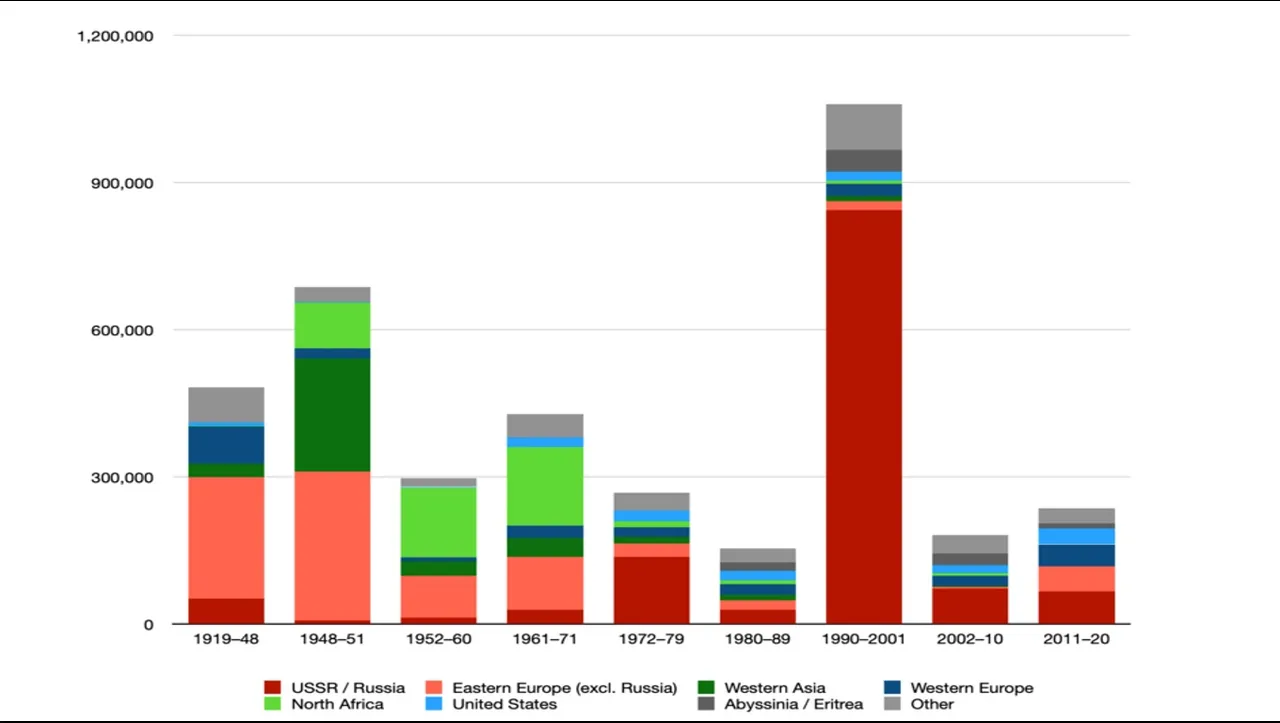
Source: Wikipedia
Note: In the 1990s a large percentage of migrants to Israel came from the former Soviet Union, see Part 1 for explanation.
At the end 19th century, the percentage of Jewish people residing in the Palestine Region was very small (less than 5%). From this perspective, they appear to be outsiders. Jewish people have lived outside the Palestine Region for centuries. During this time, due to interracial marriages and conversions to Judaism, people of Jewish faith have become racially diverse (Wikipedia, RAC and many other sources). See the map below for a better idea.
Figure 4: Jews Around the World
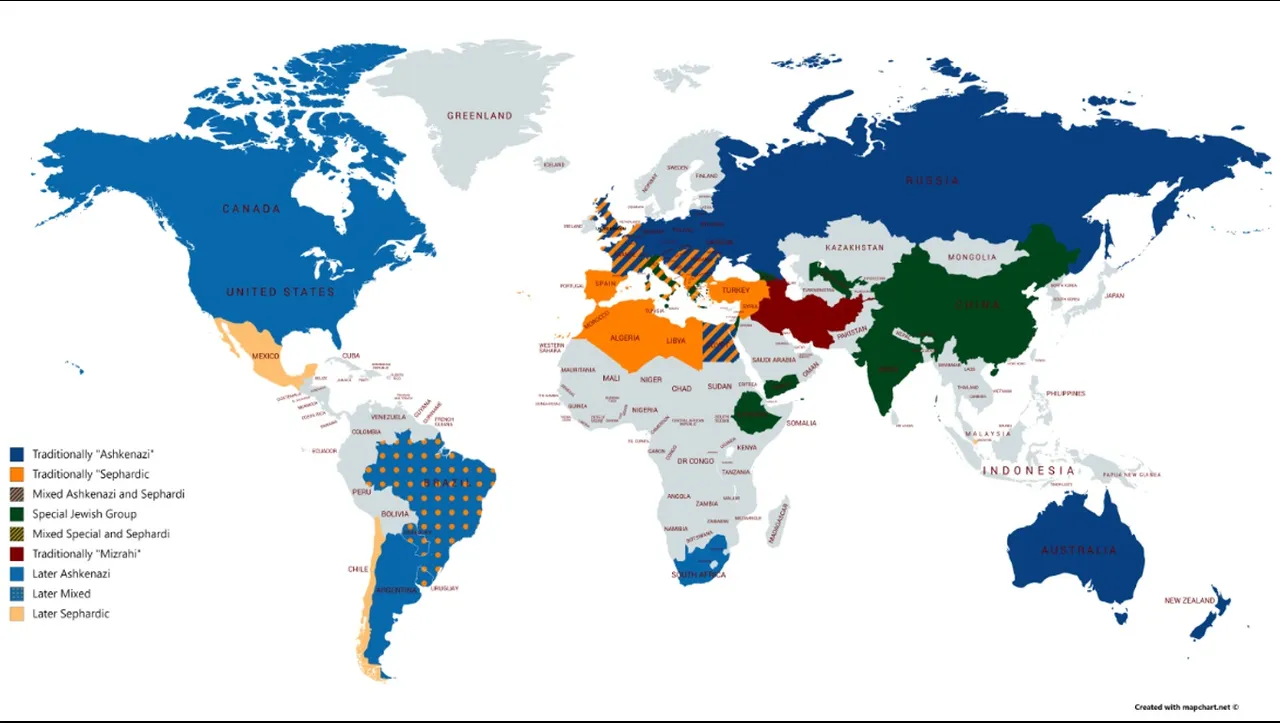
Source: Wikipedia
Based on recent rapid migration and looser hereditary connection to the region, modern day Jewish Israelis can be easily perceived as the outsiders. However, modern Jewish people, like the original Levant people, have faced extensive persecution. This persecution has been the main reason Jewish people have needed to relocate. The creation of a Jewish State is a possible solution. The creation of a Jewish State in the approximate location of the Kingdom of Israel has some logic to it. The people are connected to this region by both religion and culture.
The biggest problem with the location of Israel is that it is surrounded by predominantly Muslim countries. The Governments and the leaders of these countries despise Jewish people. Sadly, the people from these countries have been raised to share these sentiments. Jews used to live across the Middle East. Between the late 1940’s and early 1970’s almost 1 million Jews were forced out of their countries. In doing so, they were forced to leave behind their assets and their homes (World Jewish Congress).
History of Tensions Beyond just Israel and Palestine
Tensions between Muslims and Jews dates back to the creation of Islam (Unpacked). Arguably, the problems between Israelis and Palestinians are magnified by their history (faith, culture, race, etc.) as well as manipulation of religious ideology. Throughout much of history, Jews living in the Middle East have lived under Muslim rule. There have been periods of harmony but often the Muslim leadership become the oppressors. This often results in vast numbers of Jews being displaced. A recent example would be the 1979 Islamic revolution in Iran (Wikipedia).
Mistakes from the Start
The creation of Israel added to the natural tensions between Muslims and Jews. Arab Muslims have consistently opposed the presence of a Jewish State in the Middle East. The creation of Israel was not just contentious but also badly mismanaged. I believe the early decisions are largely responsible for the extent of the tensions between Israel and its neighbours.
Prior to the Great War (before 1914), a large part of the Levant Region was under the Ottoman Empire. This included modern day, Israel, Palestine, Syria, Lebanon, Iraq, and Jordan. After the Great War, control of these territories of the former Ottoman Empire were divided between Britain, France and eventually Saudi Arabia (Wikipedia). The territories Britain controlled were known as the British Mandate (modern day Israel, Palestine, Jordan, and southern Iraq). Part of that was the Mandate of Palestine, which consisted of Mandatory Palestine and Transjordan (granted independence in 1946) (Wikipedia).
Figure 5: Levant Region (Modern Day vs. Ottoman Empire)
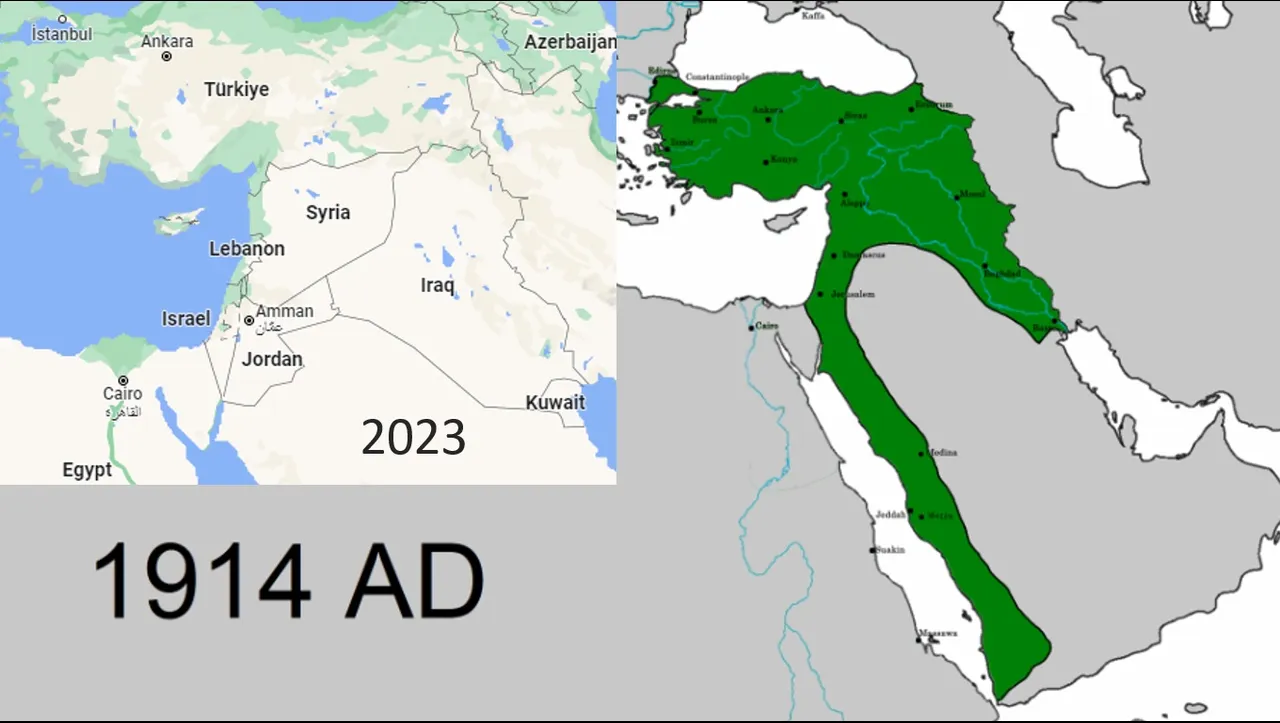
Source: Wikipedia
The mandate required Britain to put into effect the Balfour Declaration's ‘national home for the Jewish people’ alongside the Palestinian Arabs. The Balfour Declaration was signed in 1917. Therefore, the reference to Palestine would have included the land designated to Transjordan, which was created in 1921 (Jewish Virtual Library). The 1919 proposal at the Paris Peace Conference confirms this intention, see Figure 6 (Wikipedia).
Arguably, the creation of Transjordan could have served as the division in land for the Jewish people and the Palestinian Arabs. The land west of the River Jordan could have become Israel (a compromise to the 1919 proposal). However, the negotiation process did not conclude, as the British wanted the approval of the Arab nations (Jewish Virtual Library).
In 1937, the Peel Commission, proposed the division of Mandatory Palestine into a Jewish State and an Arab State; the Arab State would merge with Transjordan (a similar plan, the Bernadotte Truce Plan, was revisited during the 1948 war). This division of land was very unfavourable to the Jewish settlers and still did not satisfy the Arab settlers or neighbouring countries. Eventually, Britain passed the responsibility of dividing land to the United Nations (Jewish Virtual Library).
In 1947, the United Nations proposed and approved a partition plan for Mandatory Palestine (Resolution 181). The divide was incredibly messy as it was based around the location of Jewish towns and villages, which spread across Mandatory Palestine. Despite appearing impractical, the United Nations General Assembly voted 33 to 13 in favour of it (Wikipedia). Muslim countries strongly objected to the plan. The British Representative to the UN abstained from voting in fear of upsetting the Arab nations.
Figure 6: Maps of Mandate of Palestine, 1919 Paris Peace Conference, Peel Commission and Proposed UN Partitions
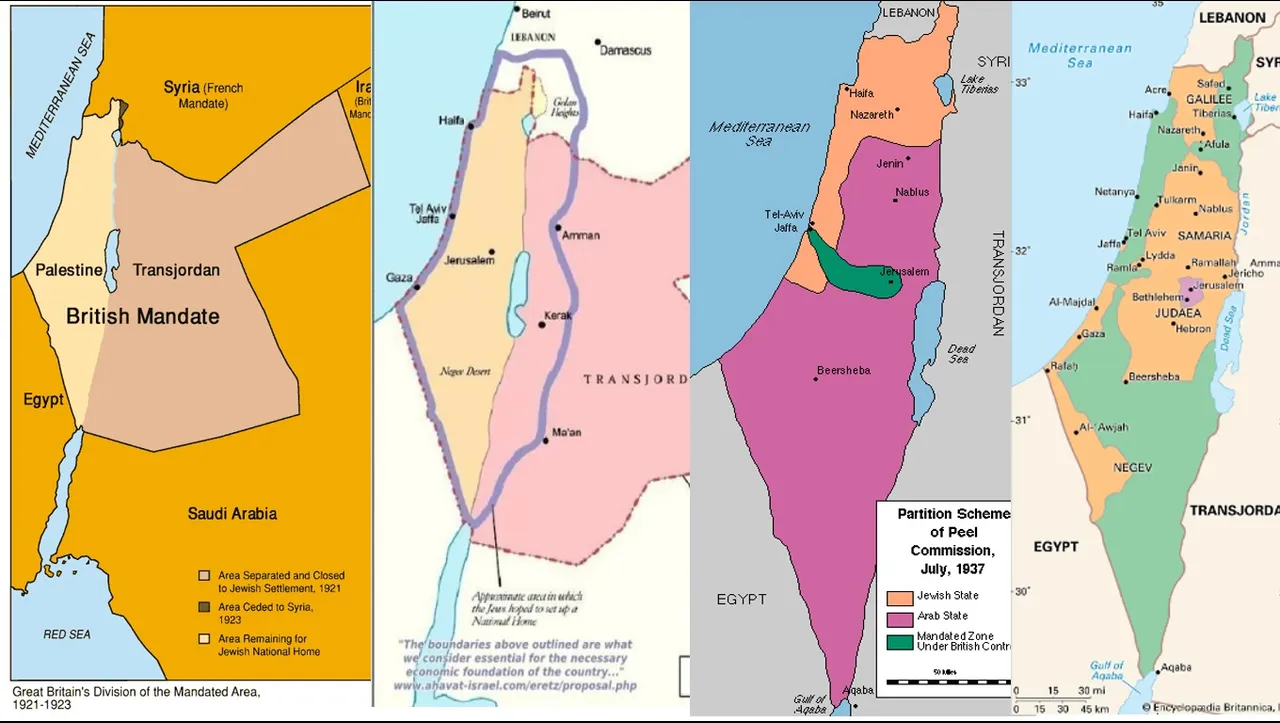
Sources: Various, refer to text
It was determined the Mandate would end on 14th May 1948. Britain pulled out without a formal transition period or any plans for governance to be implemented (Wikipedia). On 15th May 1948, day after Israel was declared an independent state, war broke out between Israel and its Arab neighbours. The war continued until early 1949, when Israel signed separate armistices with Egypt, Lebanon, Transjordan, and Syria. Egypt occupied the Gaza Strip and Transjordan occupied most of the West Bank that the United Nations had proposed to allocate to the Arab Palestinian State (Wikipedia). At the end of the war, Israel had obtained more territory than was proposed by the United Nations and the UN intended Arab Palestinian State did not come into existence. See maps below.
Figure 7: UN Proposed Map vs. Map after the War
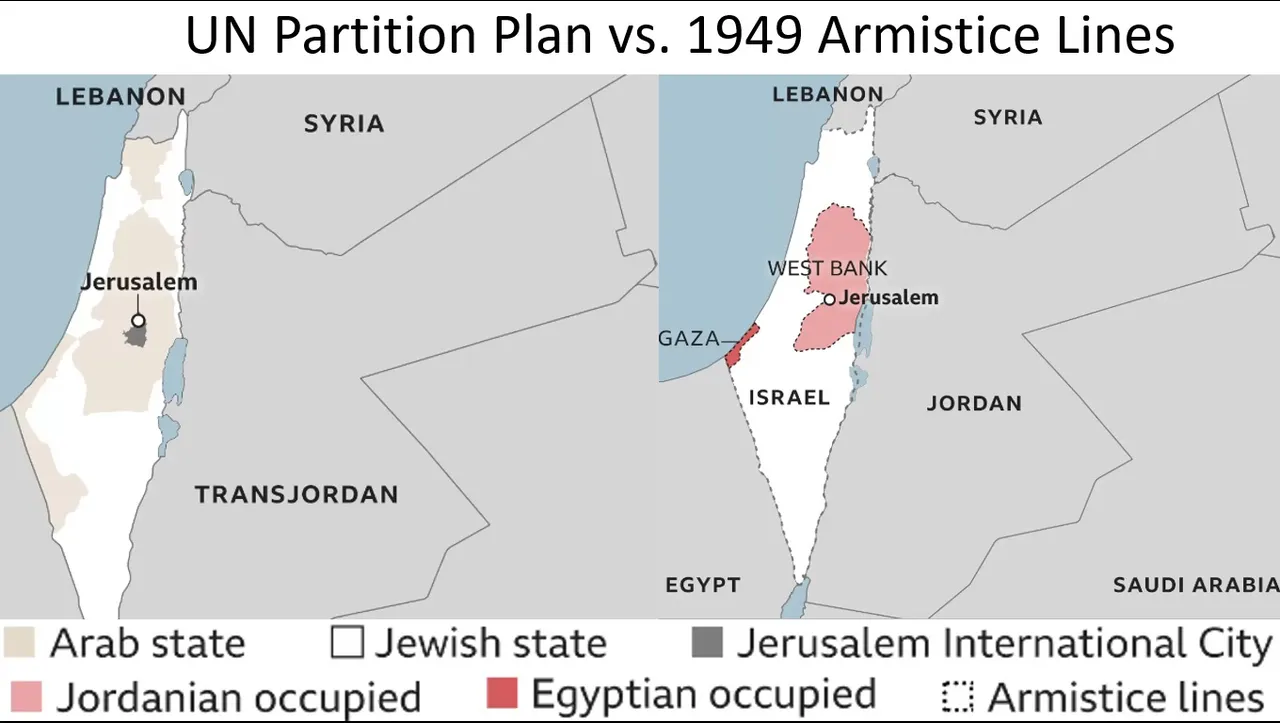
Source: BBC
These new borders remained in place until 1967. During that period, tensions ran high with neighbouring countries such as Egypt, which closed the Suez Canal to Israeli shipping. This eventually led to the 1956 war. After this war, tensions remained high. This led to the 1967 war (Six Day War), which resulted in changes to the borders. Both Gaza and the West Bank were returned to Israel. Areas designated to Palestinians were reduced after these conflicts. This was argued to have resulted in the displacement of Palestinians (Wikipedia). However, many of the Palestinians who fled the West Bank had Jordanian citizenship. They resettled in other parts of Jordan to flee the war (Jewish Virtual Library).
Despite the tension with neighbouring countries, prior to 1967, there was relative peace between Israel and the Palestinians. We can measure this by the relatively few terrorist attacks on Israel. For example, between 1960 and 1965, there was only one reported terrorist attack. This attack caused the injury of one person and nobody was killed (Johnston’s Archive). In 1968, more people were killed or injured from terrorist attacks than the previous ten years combined (Johnston’s Archive). Ever since, violence has remained high. A two state solution has been repeatedly attempted. It has repeatedly failed.
How to Fix the Problems?
The events of 7th October have ruined any possibility that a two state solution will ever be viable. Therefore, something else needs to take its place. There are many possible approaches. However, none of them are likely to be acceptable to all parties. Below are two are two such possible solutions.
One State Solution
I believe a one state (unitary state) solution would also fail. Eventually, the Palestinian and other Muslim populations would exceed the Jewish population. The Palestinian population increases at a faster rate than the Israeli population. This is because they have consistently higher birth rates. Despite net emigration, the population of Palestine has increased by 150% in the past 30 years. The population of Israel has also substantially increased but not to the extent of Palestine’s (approximately doubled during that time). See Figures 8 and 9 below.
Figure 8: Palestine Population Growth
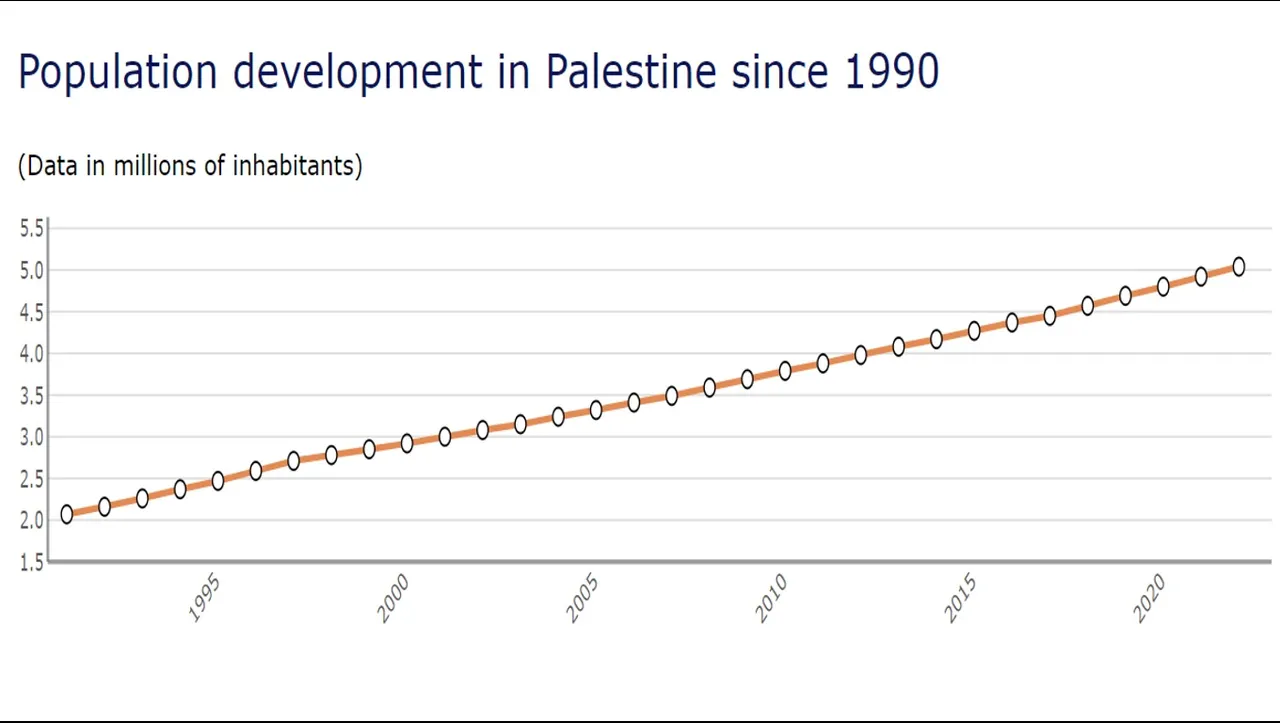
Source: World Data
Figure 9: Israel Population Growth
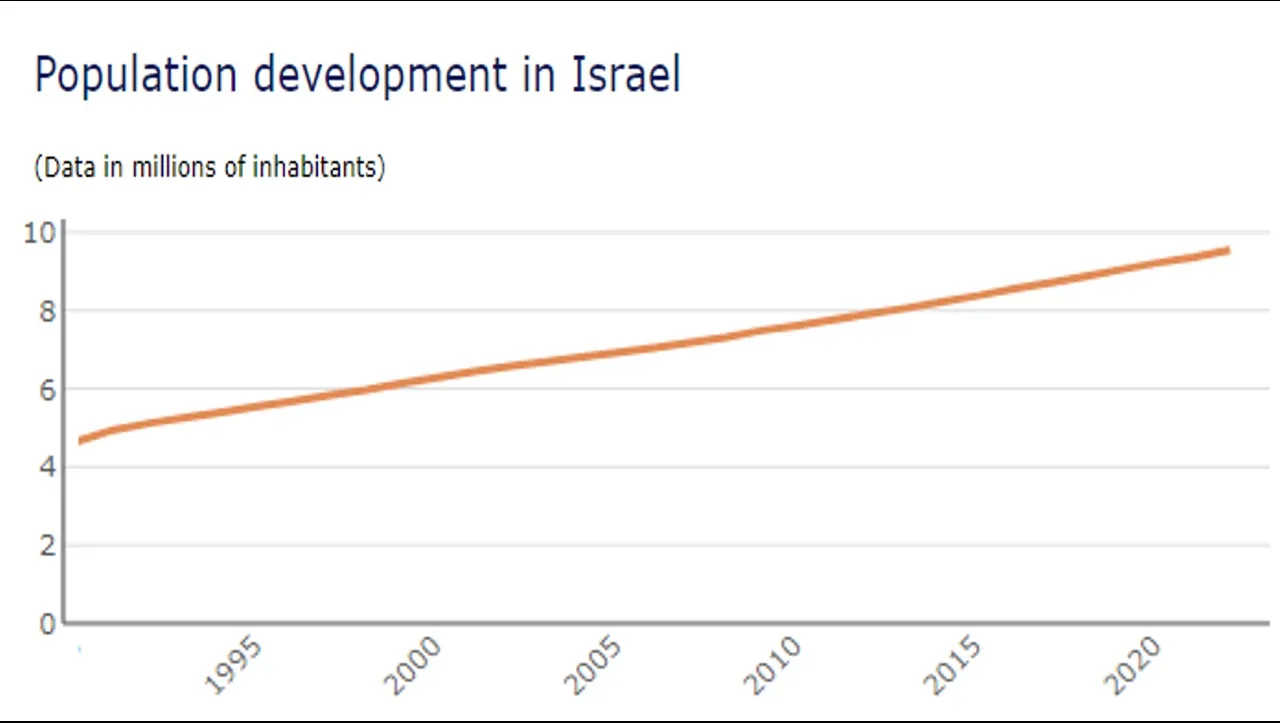
Source: World Data
As of 2022, the Palestine Territories and Israel were determined to have an annual natural population increase (based on births and deaths) of 2.5% and 1.4% respectively (PRB). Not all of Israel’s growth has been from the Jewish population. Approximately, 75% of Israeli’s are Jewish (World Data).
A one state solution could be used to enable mass migration from other Muslim countries. For example, millions of Jordanians claiming to have Palestinian ancestry could flood Israel. The Muslims would use their majority to form Government. Israel would likely be renamed Palestine and become another Muslim State.
Quasi Three State Solution
The two state solution has failed and the one state solution would erode the viability of Israel as a Jewish homeland. Another option is a three state solution. Palestine more closely resembles two states than one (Gaza and West Bank). After Hamas is defeated, there would be a power vacuum. Israel would not be able to fill that vacuum. If left to the Gazans, that vacuum would be filled by another terrorist group. The most logical and convenient approach would be to hand Gaza over to Egypt. Egypt would decide if Gaza could eventually self-govern. A continuous block of the West Bank could be handed over to Jordan. Jordan would then determine if the West Bank could become an independent state.
This solution is problematic, as it requires agreement from both Egypt and Jordan. Jordan might be persuaded but Egypt appears hostile to Gaza and would see them as a burden, threat, or both (The Atlantic). Egypt clearly demonstrate this with their stance towards taking Gazan refugees. Palestinians would also strongly oppose losing their statehood even if that was only temporary. The international community would also not support such a suggestion.
Final Thoughts
The purpose of this part of the series is to add context to the Israel and Hamas war. One of the reasons people have responded so negatively towards Israel is because of the perception of Israel being the oppressor and Palestine the victim. In reality, it is far more complex. This post is based on my perceptions of the information I have explored in a relatively short time. Therefore, it is far from expert analysis. However, the post discusses certain facts and perspectives most people are not fully aware of or do not completely appreciate.
In the final part of this series, I discuss the possible outcomes of this war and broader implications. I also discuss conspiracy theories and hypotheses. I explain why I believe many people are falling into the same traps.
More posts

I have several collection of posts. I have organised these collections based on content and purpose.
The first collection contains six collection posts created before PeakD had the collection feature. Four of these posts relate to the core of my content, one of them contains all my Actifit Posts, and one of them contains my video course ‘Economics is Everyone’.

The second collection consists of the posts that I consider define my channel. These posts are significant in terms of content as well as how they contribute to the growth of the channel. These posts reveal the most about what I believe in.

The third and fourth collection is what I call my ‘Freedom-base Economics living book’. They contain all the posts that support my ideas about the value and power of freedom. Some of these posts explain what we can achieve with freedom and what we need to utilise it. Some of them explain how we are deprived of freedom and how we often give up freedom for security and comfort. The third collection concludes with possible scenarios depending on what we (society) choose to do.


Hive: Future of Social Media

Spectrumecons on the Hive blockchain

